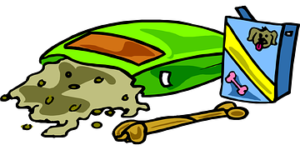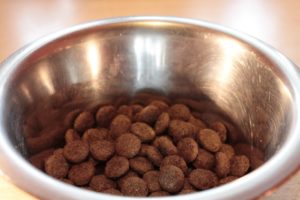If you love your pet, there are some facts you should know about commercial pet food. Below are the 5 that I consider the most important to keep your dog or cat healthy.
1. Don’t listen to the marketing hype. The pretty pictures on the pet food packages and in advertising do not always tell the truth. You won’t know what’s really in that bag of food unless you read the ingredients label and even then, nothing is certain. Remember when Blue Buffalo used to inundate nighttime television with their commercials telling us that their pet foods contain only good stuff and “no by-products?” The truth came out when Nestle-Purina went after them in Court, alleging that Blue Buffalo’s pet food most certainly did contain chicken by-products. Nestle-Purina had the proof to back it up and won the lawsuit. Don’t believe the commercials and advertisements. Buy from companies with reputations for honesty and integrity. For more on this subject, check out this link.
2. Dogs and cats may be cooked in your pet’s food. Yes, it is true. If your pet eats dry food containing by-products (of any kind), animal fat, animal digest, meat meal or meat and bone meal, you should know that the final product very likely will contain dead dogs and cats, among other detritus. Here is how that happens:
All dry pet foods are rendered. If the meat is a named meal, such as chicken meal or lamb meal, you can assume that will be the only meal in the finished product. But the generic meat meal and the other items listed in the previous paragraph are created in general rendering vats. Everything but the proverbial kitchen sink is likely to go into those vats. Rendering trucks go around to restaurants and pick up the old drums containing rancid fats that may have been sitting outside for weeks in kinds of temperatures. They also go to supermarkets and pick up containers of outdated meats that have been sitting around awhile. Rendering trucks go to veterinary offices to pick up the euthanized dogs and cats and other deceased pets, and they also go to farms and zoos to get the dead animals in those places. All of those dead animals, meats and fats are then delivered to the rendering companies, where they are dumped, as is, into the big vats to be made into pet food. No, they don’t remove the styrofoam packaging and plastic. No, they don’t remove collars and metal tags from dead animals. It all goes in. The contents are then cooked at very high temperatures to kill the bacteria and reduce the contents to a powder which later becomes dry kibble. Yes, the heat is enough to kill most organisms, but it won’t kill pentobarbitol. That is the drug veterinarians use to euthanize animals. Pentobarbitol has shown up in commercial pet food. The Food & Drug Administration has confirmed this. Avoid buying pet food that contains those 5 ingredients listed above to be sure your dog or cat are not consuming their own species.
3. Grains are not a good choice for pet food. Some manufacturers use grains, like corn or wheat, in place of real meat in their products. While it is true that corn, for example, does contain some protein, it is a plant protein and dogs and cats don’t easily digest plant proteins. Some animals are even allergic to grains like corn. But there is a bigger reason to avoid grains in pet food. Because the grains that are delivered to pet food companies for use in their foods are stored outside (and may have been stored outside prior to that), the grains are subject to mycotoxins. There have been several outbreaks of mycotoxins in pet food grains in recent years, including a new one in 2016. Canadian Biotoxins has reported that early samplings show high incidents of mycotoxins and molds in this year’s crop of feed grains. Along with insect infestation, molds and various kinds of toxins create problems with grains in pet food. These molds often are not found until the consumer opens the package and begins to pour it out into a feeding dish.
4. Know where your choice of pet food is produced and processed. With all the problems since 2007’s poisoning of so many dogs and cats by melamine in Chinese-sourced wheat, American pet owners have become very conscious of the source of the food products they buy, including pet food. Then we saw another scary event with the jerky pet treats beginning in 2007 with more than 6200 dogs and 26 cats and 3 humans experiencing various degrees of illness from eating jerky pet treats made in China. At least 1400 dogs died. Most of the treats were chicken jerky and also duck and sweet potato treats. Some suspected brands were recalled by their manufacturers but were eventually put back on the market with no discernible changes in formula.
As of their May, 2016, update, the Food & Drug Administration still doesn’t know the cause of the illnesses or exactly how the jerky treats could be involved. Their investigation did discover that an illegal antibiotic residue was found in the treat samples but no one, including the FDA, believes the drug was the cause of all the illness and deaths of so many pets. The solution is easy: Don’t buy any pet foods or treats made or processed in China. That country does not allow inspection of their pet food manufacturing processes and are decidedly secret about anything to do with their own health inspections of products. Don’t take the chance. If you are in doubt about some of the ingredients in a pet food you buy, call the manufacturer and ask. Usually, they will tell you if any part of a product is made or processed in China. The other problem consumers now deal with is the United States passed a law allowing chicken grown and butchered in this country to be shipped to China for processing and packaging and then shipped back to the U.S. for sale. It is important to also know the source of the chicken used and where it was processed.
5. Read the pet food package label of ingredients and understand it. If you don’t, you have no way of knowing what might be included in your dog or cat food. You want to know that the first 4 ingredients listed carry the most weight in the food. If the first ingredient is corn, followed by corn gluten meal, it means your pet is receiving corn instead of real meat as the weightiest ingredients. Ideally, you want 1 or 2 quality meats listed in those first 4 ingredients. Look here for what your dog or cat should and should not eat.
If you know and understand those 5 things, you should be able to provide a healthy diet for your dog or cat, knowing you can choose the perfect commercial pet food.


